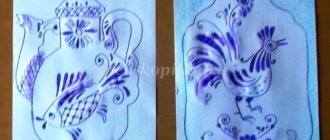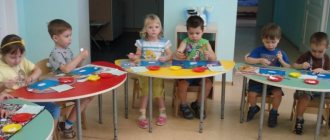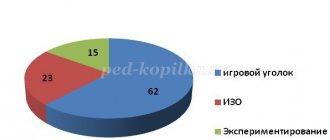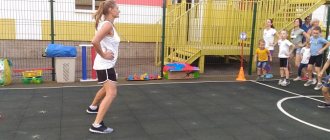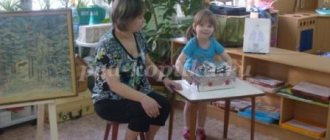Areas of productive activity
There are several areas of productive activity:
- creating objects suitable for research and educational activities, as well as for games;
- filling the art gallery with handmade objects;
- creation of layouts;
- creation and design of a “book” filled with children’s stories, a nature diary, a group’s chronicle, and fairy tales;
- production of souvenirs and decorations for holidays in the form of posters, invitation cards, greeting cards, Christmas tree decorations, garlands, etc.;
- inventing a collective story, unusual in that all the words begin with the same letter (such an activity perfectly develops children's oral creativity skills, helps them master writing and reading);
- creating theatrical materials for your performance - making elements of costumes, scenery, etc. Productive activity here is successfully associated with a plot-based children's game or reading fiction.
The work done gives the following results:
- a system of productive activities is being created for older preschoolers;
- children develop creative abilities;
- in a group, children’s psychological well-being improves;
- children are successfully preparing for school.
Typically, productive children's activities are closely associated with such areas as: artistic creativity, cognition, socialization, communication, work, and safety. When engaging in artistic creativity, there is an excellent opportunity to develop children's speech. At this age stage, there are still many problems in children's speech: it is monosyllabic, rather poor (due to an insufficiently rich vocabulary), composed only of simple sentences, and non-literary expressions and words are often used. Also, the use of the method of productive activity has a huge impact on the moral education of children. In the process of performing various practical works, a similar connection is formed and begins to operate in children. In addition, these classes help consolidate knowledge gained from the outside world and develop a number of useful qualities:
- activity;
- observation;
- independence
- determination;
- the ability to finish what you start;
- ability to assimilate received information;
- patience.
Productive activity also affects the physical development of a preschooler. During classes, children's vitality increases, their mood and behavior improve, and their character becomes more active and cheerful. The child himself becomes much more mobile. During classes, it is necessary to develop in children the correct gait, posture and other physical characteristics of the body, which will be very useful for the little person in life. Children's muscles and vestibular apparatus become stronger, and their movements become more coordinated.
GCD summary for the senior group “Give a piece of goodness”
Summary of GCD for the senior group. The purpose of using ICT in NNOD : the formation of cognitive interests and cognitive actions of the child in various types of activities, supporting the motivational line throughout the entire NNOD, enhancing the cognitive activity of children, concentrating the attention of preschoolers
The goal of NNOD is to develop in a child the desire and ability to think creatively, analyze the world around him, studying himself from the position of goodness, justice, and love.
Objectives of the priority educational area:
Social and communicative development:
- continue familiarization with the polar concepts of “good” and “evil”;
- to form a conscious attitude towards social norms of behavior;
- develop emotional responsiveness, empathy, goodwill, desire for charity, readiness for humane actions.
Educational objectives in the integration of educational areas:
Artistic and aesthetic development:
- promote the development of creative thinking through creating a drawing according to your own design;
- improve the ability to complete the work started.
Cognitive development:
- improve cognitive activity;
- to form the concept of “charity” in children;
- develop the ability to observe, isolate, compare, analyze.
Speech development:
- develop coherent, grammatically correct speech;
- intensify the use of the new word “charity” in speech.
Physical development:
- develop fine motor skills of the hands;
- achieve a positive emotional state.
Preliminary work: reading fairy tales, discussing cartoons watched at home; conversations about stories on moral topics, looking at illustrations with various situations, playing out situations.
Planned results : the child has a positive attitude towards the world. The child actively interacts with peers and adults; able to empathize with failures and rejoice in the successes of others. Has primary value ideas about “what is good and what is bad”, strives to do good; Shows respect for elders and care for younger ones. The child has a fairly good command of oral speech, can express his thoughts, use speech to express his thoughts, feelings and desires, construct a speech statement in a communication situation. Shows interest in productive activities, developed fine motor skills, masters basic movements, can control and manage his movements.
Prerequisites for UUD : communication – listening skills, ability to participate in joint activities in a subgroup, ability to answer questions.
Regulatory – the willingness to choose an occupation according to one’s own design.
Cognitive – the ability to work from illustrations, the ability to establish cause-and-effect relationships.
Personal – the ability to correlate actions and events with accepted principles and moral standards; developing the ability to help.
Equipment for the teacher : projector, laptop, visual aid “Lessons of Kindness”, audio recordings of songs (“Smile”, “If you are kind”), video recording “On the Path of Kindness”.
Equipment for children: landscape sheet, colored pencils, cards for the game “You can - you can’t”, chips
| Activities of the teacher | Children's activities |
Introductory part (duration 5 minutes) | |
| Purpose: to attract children's attention, organizing them for educational activities | Target: inclusion in educational activities, determining the reasons for using affectionate words in speech |
| Guys, good morning! Our every day begins with the words “Good morning!”, “Hello” Why do we say these words? | Children's answers |
| Saying these words, we wish our loved ones and acquaintances a good mood, good health, so that we have a good and kind whole day. When we are in a good mood, we smile, it seems to us that we can do anything, we even want to share our good mood with passers-by. And the good returns, passes from one person to another. It is very nice to say kind words to others. Let us also greet each other and exchange kind words. Greeting "Magic Ball" | Children sitting on the carpet in a circle pass a ball of thread and say a kind word to their neighbor |
Main part (20 minutes) | |
| Goal: to instill in children the need to do kind deeds towards their loved ones, acquaintances and strangers, and animals. Form a conscious attitude towards social norms of behavior. Enrichment and activation of the vocabulary “Charity: “good” (good), “create” (do) - do good. Develop fine motor skills. | Goal: Take part in the discussion. Show off your ability to make gifts according to your own ideas. Completing grouping tasks. |
| Game-dramatization “A good word heals, but a bad word cripples” Guys, did you know that with the help of words you can create miracles? A word can make a person laugh, upset, or offend. When a person is upset or offended, it is very difficult for him to cope with a bad mood, but a kind word can console him. Let's remember Agnia Barto's poem: Our Tanya is crying loudly, She dropped a ball into the river. Hush, Tanya, don't cry. The ball will not drown in the river. | Children listen to the teacher's words |
| The teacher reads the poem and shows it with gestures and facial expressions. – Do you think Tanya will stop crying? Why? | Children's answers |
| Of course, the words addressed to Tanya should help her, comfort her. What other good deeds can children do? | Children's answers |
| What can you call adults, children, fairy tale and cartoon characters who come to the aid of others? | Children's answers |
| Children, do you know what the word “charity” means? | Children's guesses |
| “Charity” consists of two words “good” and “create”. “Good” means “good”, and “create” means “to do.” So the word “Charity” means “to do good.” – And now I want to check whether you can distinguish good deeds from bad ones. | Children listen to the teacher's words |
| Game "You can - you can't." You need to divide into 4 teams. Each team needs to distribute the chips among the cards. Green chips mean good deeds, and red chips mean bad deeds. | Children are divided into 4 teams. Each team selects and distributes chips onto cards. The quiet melody “If you are kind” sounds |
| – Now let’s check how you completed the task. | Children explain the actions drawn on the cards. |
| Well done. Right. When a person does a good deed, provides voluntary help, it means he is engaged in charity. Voluntary help means that you will help just like that, that is, for free, at your own request. Nowadays, charity concerts . | Children listen to the teacher's words |
| Slide 1. Concert | Familiarization with the slide |
| People collect money for the construction of schools, churches, cathedrals, and for the treatment of seriously ill people. | Children listen to the teacher's words |
| Slide 2.Collecting money (People put money in a special container) | Familiarization with the slide |
| Guys, we are lucky, we have parents who take care of us, relatives, and friends. When we get sick, they always come to the rescue, treat us, and console us. And there are children who have no loved ones, no one helps them. And it is for them that such charity events are held. Charity games are held in which famous actors and artists take part, donating their winnings to hospitals and orphanages. Some people collect things to help people who do not have enough money to buy clothes and toys. | Children listen to the teacher's words |
| Slide No. 3 Collecting things | Familiarization with the slide |
| You and I can also do charity work. To do this you need to do good deeds. We can help people in difficult situations, share with others, be kind and attentive to others. If you fed a homeless kitten, or, for example, adopted a puppy, then you did a good deed towards them. | Children listen to the teacher's words |
| Slide No. 4 A child feeds a homeless kitten | Familiarization with the slide |
| If you defended a person who was being offended, then you also did a good deed. | Children listen to the teacher's words |
| Slide No. 5 A boy protects a girl from a bully | Familiarization with the slide |
| If you gave a toy to a child who lives without parents, then you are doing charity. | Children listen to the teacher's words |
| Slide No. 6 “A boy carries toys to an orphanage” | Familiarization with the slide |
| Good deeds bring people joy. And today you and I can do a good deed - we will give our kids drawings, which means we will make them happy. But first we'll warm up a little. | Children listen to the teacher's words |
| Finger gymnastics «Kindness» If your fingers are sad, they want kindness . (press fingers tightly to palm) | Children performing gymnastics |
| If your fingers cry, it means someone offended them. (shaking hands) We will spare our fingers - We will warm you with our kindness . (“wash” our hands, breathe on them) We will press our palms to ourselves , (Press your palms to your chest) Let's start stroking gently. (Stroke the palm with the other palm) Let your palms hug , Let them play a little. (Cross your fingers, press your palms together, the fingers of both hands tap quickly and lightly) Each finger needs to be taken and hugged tightly. (We hold each finger in a fist) | Children performing gymnastics |
| Let's remember the proverbs about kindness and start making gifts. - A kind person teaches goodness. “A good word heals, but a bad word cripples.” | Children say proverbs about goodness. |
| More proverbs: - Good always triumphs over evil. - A good century will not be forgotten – Life is given for good deeds. - The world is not without good people. | Children listen to the teacher's words |
| And now I suggest you draw gifts for children in the younger group. Everyone can draw something that will bring joy to our kids. | Children complete the task. The song "Smile" is playing |
Final part (reflection, duration 5 minutes) | |
| Children, what is important for you to learn today? Where can you apply this? | Children's answers |
| You and I can also do good deeds, help other people, say kind and polite words - this will make everyone better, the world will be kinder. Please, I'm telling you this in confidence. Be kind - and don't expect candy for it. Be kind - without the game and during the game. If you can, please be kind. | Children listen to the teacher's words |
| Video song “Dear Goodness”. | Children watch and listen to a video song |
Why is productive activity important for a preschooler?
The development process of a preschooler is multifaceted, and productive activities play one of the most important roles in it. Together with games, they merge into a general complex of work devoted to preschool education by the adult generation (educators and teachers). Such activities should lead to the emergence of a specific product. Experts from all over the world have conducted numerous studies with various categories of children who have not yet started school, which have shown how effective productive activity is for this age category:
- It was found that such activities have a beneficial effect on the development of graphic skills, the development of determination and perseverance in the process of mastering various skills.
- Engaging in productive activities contributes to the development of a child’s creative imagination, develops coordination of movements, hand muscles, and thinking mechanisms (synthesis, analysis, ability to compare).
- Like any other cognitive activity, productive activity also plays a significant role in the mental development of children.
- During classes, the most favorable conditions are created for the development of the necessary qualities of initiative, inquisitiveness, independence and curiosity.
- In general, the comprehensive influence of productive activity on the education of preschool children is noticeable.
- A close connection with sensory education is also noticeable. In order to form an idea about objects, it is necessary to first obtain knowledge about their qualities and properties, size, shape, color, position in space.
In the process of productive activity, physical and mental activity simultaneously manifests itself. To create a drawing, an appliqué, or sculpt a figurine, you need to master certain skills, make an effort, and perform creative actions. In the process, preschoolers learn practical skills that they will later need for a wide variety of jobs. They acquire skills that allow children to feel much more independent. The integrated approach is successfully implemented in productive activities. In addition, here children are freed from fears and stress. Modeling of surrounding objects in the process of productive activity ends with the creation of a product in which the idea of a phenomenon, situation or object receives a completely material embodiment in a design, drawing or figurine.

